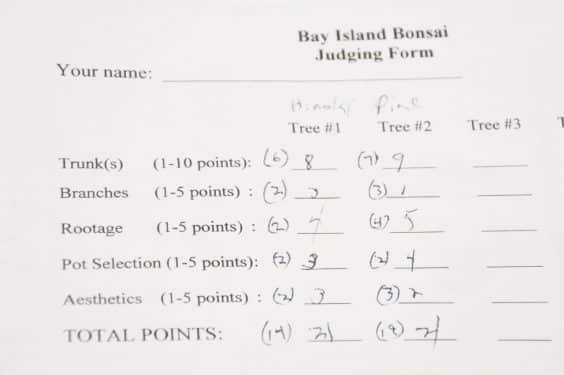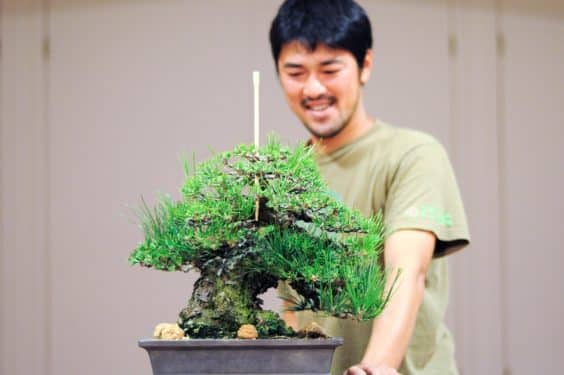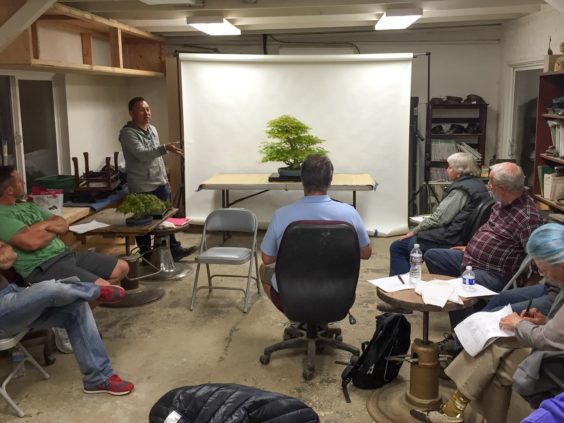A lot of the work of teaching bonsai falls to the clubs – the organizations that make the meetings, workshops and exhibits from which we learn possible.
I’ve been a member of several clubs over the years, but most of my experience has been with a single organization – Bay Island Bonsai (aka BIB).
I wanted to highlight a few BIB policies and activities that have helped me learn bonsai over the years.
- Workshops are mandatory in BIB, and thanks to Boon, the workshops are a valuable resource.
Boon in the workshop
- Members participate in evaluation exercises. By evaluating trees and reviewing our scores as a group, members can learn about the traits to look for in given varieties.
Bonsai evaluation forms
- Programs featuring visiting professionals focus on critiques of member trees. This exposes members to other professionals and provides feedback aimed at improving member trees.
Daisaku Nomoto sizing up a black pine
- Members create practice displays at almost every meeting. The year-round focus on display helps members refine their displays ahead of the annual exhibit.
Boon reviewing a practice display
- BIB encourages members to have at least 1-2 trees that will be displayed in the club exhibit. This encourages quality and provides incentive for following-through with longer-term projects.
- No tree can be shown two years in a row. This provides incentive for members who want to show trees every year to have more than one exhibit-quality tree.
- Members share trees, pots, stands and other display elements at the exhibit. This informal practice has resulted from the focus members place not just on their own trees but on the exhibit as a whole.
Many of these practices are valuable thanks to Boon. As a sensei club – a club with a teacher – we’re fortunate in that we are exposed to consistent, quality education.
Clubs without regular teachers have their benefits too – chief among them is the great flexibility they have in creating programs to meet member needs.
Speaking of which, what are the practices you’ve found most conducive to learning in your clubs?
Subscribe to Bonsai Tonight
New Posts Delivered Every Tuesday and Friday




Brian McGrath says
Hi Jonas
Missed you at the tiakan 10 this years. Was going to be the year I met you in real life. Maybe next time.
Brian from Vancouver lsland
Jonas Dupuich says
Hi Brian – Sorry I missed you too! Hope you had a fantastic time at the show.
Steven Alford says
Jonas,
I am very curious as to what you mean by mandatory workshops? How do you force members to pay $100 or so to attend a workshop?
Jonas Dupuich says
Hi Steven – great question! A condition for membership in the club is that members will take 9 1/2-day workshops a year. This is based on the premise that engaged members will be spending at least that much time working on their trees. In many ways, signing up for the club is signing up for the workshops – there is no separation between the two.
Ben MacBeth says
Jonas,
I am curious what sort of curriculum you have for the workshops. I am interested in other ideas for time spent with teachers other than the generic “Bring your own tree” frenzy which is very prevalent.
I have been involved with a local Chicago club for a few years now and would be interested in picking your brain about new learning models compared to what has happened in the recent past. I would prefer not to discuss the details on your public post however, but I understand if you have too many other things going on to discuss.
Jonas Dupuich says
Hi Ben. BIB workshops are of the bring-your-own-tree type. Because we have consistent instruction, we can avoid pitfalls of taking the same tree to different people over time. When there is a good teaching opportunity for the group, we’ll often crowd around a single workstation to watch a given technique or learn about the way a particular tree grows.
Would be happy to discuss ideas for programs. The forum, ask.bonsaitonight.com, is a good place for sharing public ideas, or we can set up a time for a call (fell free to write me and we can set something up).
Charlie Mosse says
How many members are in BIB’s?
Charlie
Jonas Dupuich says
Hi Charlie – am not sure how many members there are, though I can say the club is not large.
Charlie Mosse says
We have about 250-300 members. We do limit the numbers is a workshop to 4-10 depending on the workshop. We are evaluating what we are doing to improve the membership’s learning/enjoyment and to improve our trees and displays. I see that the few clubs who have a sensei or some kind of focused guidance do so much better, especially when that someone is Kathy Shaner or Boon. Very few clubs have that kind of named leadership. Good for them.
Zack Clayton says
Columbus historically has mixed it up between beginner and advanced. We have a November Tool Care and Winterization session and a January “So you got a tree for Christmas (and it died)” session. July is our show. September is a club picnic and member sale, December is our holiday banquet and silent auction. The other months are open season. We aim for 3-4 workshops during the year led by club or regional talent. We have a very good sensei who specializes in tropicals. Most other non workshop sessions are demos or lectures on a technique or style. Our newsletter includes a tree of the month and a book review along with additional material on the (ideally) upcomming workshop or demo (post mortem if we can’t get copy in advance) if we can get the presenter to write it. Your link has been provided in several articles as additional information. There is a core group who is comfortable speaking in front of the club, but sometimes we feel that people get tired of the “_______ talking head show” so we tend to self limit to a couple of times a year. Our “advanced group” is informal and we meet once a month to work on the Franklin Park Conservatory collection. That is probably where most of our advance learning takes place under the sensei I mentioned.
We have a website, but it is badly out of date and a committee is working on a revamp. Old newsletters (since we went digital) and an index of articles and tree of the month are listed.
Zack Clayton says
I forgot to mention – we also present a beginner class in conjunction with Oakland Nursery and one for Franklin Park Conservatory.
Jonas Dupuich says
Thanks for sharing Zack – sounds like an ambitious program!
David Alip says
I have been a member of BIB for a few months. I only attend half days but I find them very, very valuable. Sensei Boon is very hands on and will teach you every technique you need to be successful in Bonsai. Workshops are a mix of beginners and advanced. I learn a lot from other members too. Last workshop I brought an airlayered maple from a local nursery. During the repotting we discovered that the soil was composed of organic and inorganic materials. There was little feeder roots and a lot of root rot. Beside me was an advance member who had another airlayered maple with inorganic soil(pumice, lava, akadama). He sifted it himself! The feeders and root network on his was amazing. Of course I would not debate on others who uses inorganic materials. But seeing this myself is a good experience and lesson to carry for my future trees.